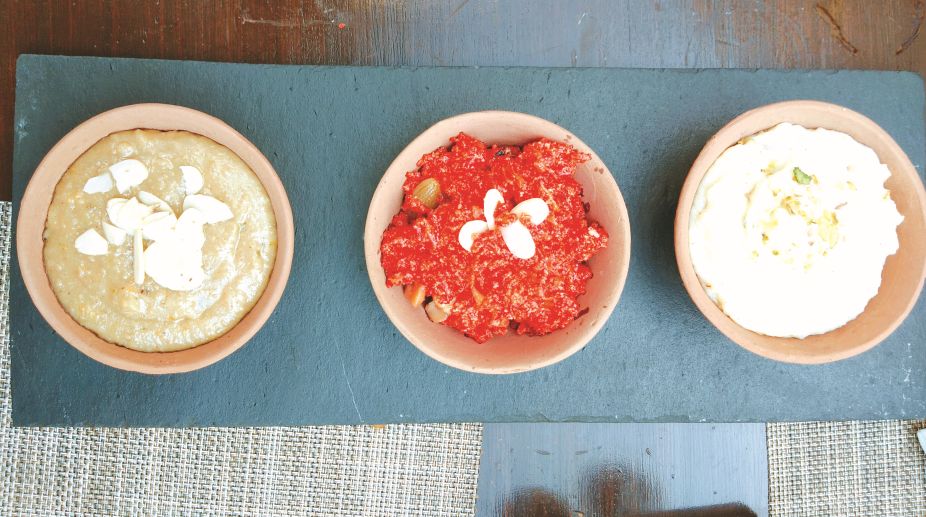CM Yogi’s initiative bears fruit as over 16 lakh farmers’ IDs created in UP
The Yogi Adityanath government has launched extensive campaigns across Uttar Pradesh to ensure farmers benefit from government schemes.
With its rich history and a melange of cuisine forms, Rampuri cuisine is an almanac of recipes for the modern chef. Suchayan Mandal traces the history of this repository of gourmet cooking
Suchayan Mandal | April 12, 2018 2:03 am

Rampur has an old worldly charm. A rich kingly affair that is now survived by its cuisine has brought the world together through its taste buds. The quaint little town in Uttar Pradesh has a legacy, for Mirza Ghalib had spent a considerable part of his life here.
Lost in India’s tourist map, Raza Library at Rampur is home to hundreds of Persian and Urdu literature and manuscripts that are well-preserved. And this is the library that provides the modern day chefs with recipes of the nawabs and is quite popular in the food circuit as Rampuri cuisine.
Advertisement
So, how can a sub-divisional town in Uttar Pradesh be such an influencing factor? As John Biswas, Executive Sous Chef at JW Marriott Hotel, New Delhi Aerocity, believes, the rich lineage in flavour has made the cuisine of this place a marvel even after the fall of the empire.
Advertisement
Believe it or not, kings have an influence on popularity of a cuisine. And this is true for most of India’s regional cuisine because kings at the end of the day had the finance to fund for a chef’s experiment.
The Statesman met Chef Suroor Khan, who was in Delhi recently to promote Rampuri Cuisine at JW Marriott Hotel, at Dine Like Royals festival to understand the under-layers of this much talked about cuisine of the country.
History
If one has travelled by road from Delhi to Nainital, there is no way one could miss this quaint little town. The old town, though, doesn’t intimidate a visitor with its rich history.
This town was a 15 gun-salute princely state of British India. It came into existence on 7 October 1774 as a result of a treaty with Oudh. Following Independence in 1947, Rampur State and other princely states of the area, such as Benares and Tehri-Garwal were merged into the United Provinces.
Cuisine’s evolution
Though situated in Oudh’s bordering region, the Nawabs of Rampur have always favoured a specialised cuisine. After the Indian Mutiny of 1857, the chefs, or khansamas, from the erstwhile Mughal Imperial courts shifted to Rampur, bringing along with them the Mughal cuisine tradition. There was also a heavy influence of Awadhi, Hyderabad and Kashmiri cuisine, which created a unique blend of culture in the cooking pot.
Meat-heavy
Rampuri cuisine is predominantly Pasthun, which is largely based on meats. The kings of Rampur, said Suroor, would have specialised chefs to look after each dish of rice, meat and sweets. Basically, the royal kitchen provided employment to a lot of people, who would put their expertise in every item on the menu.
The Nawabs would encourage chefs to travel around and experiment with food. This gave the chefs a significant boost to develop new trends in traditional dishes, which is how Kachche gosht ki tikia, Afghani Chapli Kebab, Murg Changrezi and Gosth ki halwa came into existence.
Basic ingredients
Unrefined raw spices (khada masala) form the basis of the dishes of Rampur. And what are these spices? Well, most of Rampur’s dishes are prepared with black and white peppercorns, cloves, cinnamon or cassia bark, mace, black and green cardamom pods, bay leaf, cumin and coriander.
And the most important flavour behind the delicacy is yellow chilli. Rampur is built on the banks of Kosi River. The flood plain of Kosi grows this unique yellow chilly. This chilli, fried in oil, is used in meat dishes as a flavouring agent. Besides, yellow chilli powder is also used.
Staple
Chef Suroor said the staple for Rampuri royalty would be a meat-heavy affair. There would be kachche gosht ki tikia, fish anjeer tikka and Mirch ka Halwa with Biryani. The kings were fond of hunting and hated to wait for the hunted animal to be cooked.
So the royal chefs devised a technique by which the meat of the hunted animal will be cooked without marination while the king continued his hunting. And that’s how Kachha Gosht ki Tikia got invented.
For staple meals, the common people of Rampur stock raw unrefined masala at home. While lentils, rice and wheat are the basics of their daily diet, Rampuri commoners would gorge on Gosht every day.
Festival food
Having a history of Nawabs, it would be a mistake to believe that only Islamic festivals would be celebrated in Rampur. Diwali, Ram Navani and Janmasthami are celebrated with same fervour as Eid-ul-Milad, Bakr-Id and Eid-ul-Fitr. And that’s where food plays an important role.
A place ruled by Nawabs, who were fond of food, ought to have people who love food equally. That’s how Tar Qurma became quite popular as a festival food. Besides, Mash ki dal, Baingan Nawabi and Badam ki Roti are a few special delicacies.
Advertisement
The Yogi Adityanath government has launched extensive campaigns across Uttar Pradesh to ensure farmers benefit from government schemes.
An afternoon at Mirza Ghalib’s favourite perfumery takes you back aeons, says KRISHNARAJ IYENGAR
At least 36 people were missing after a cloudburst in Rampur in Himachal Pradesh's Shimla district, officials said on Thursday.
Advertisement
